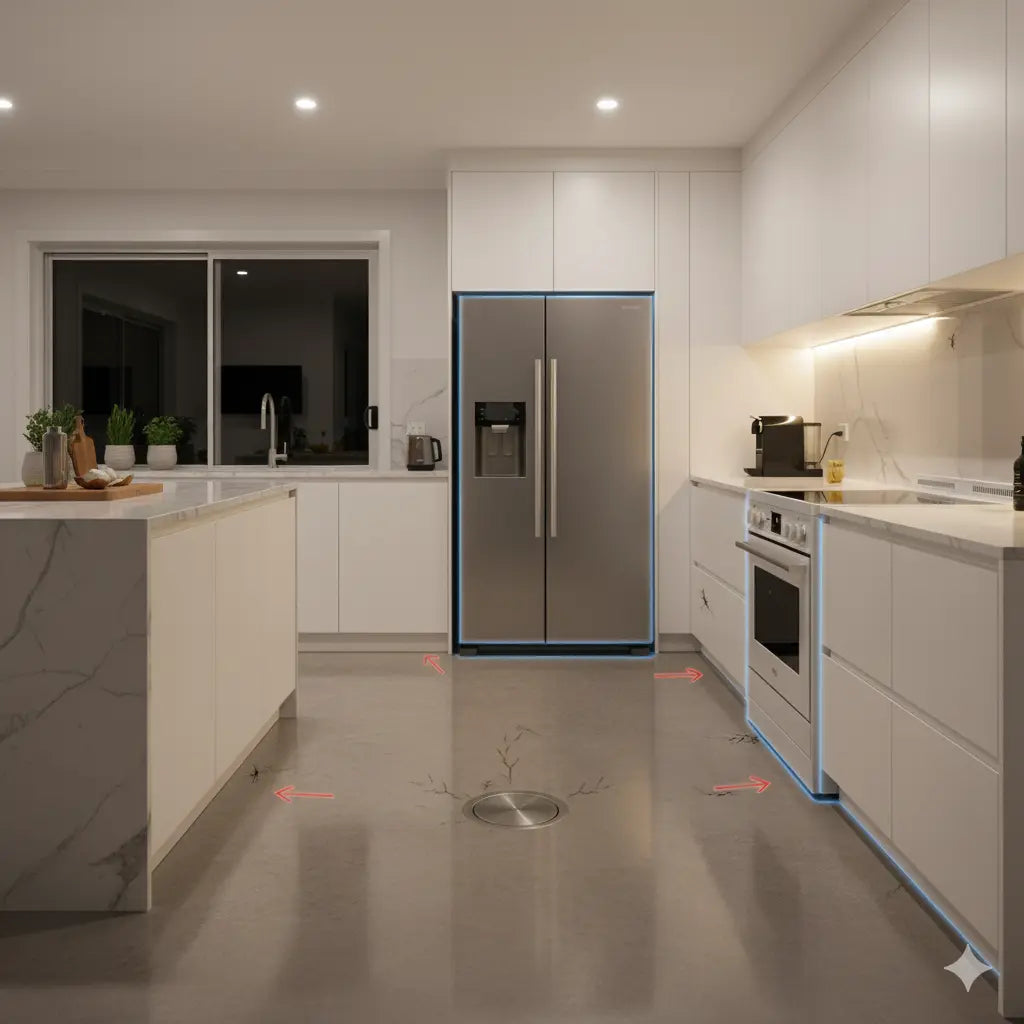
5 Common Pest Control Mistakes Making Cockroaches Worse in GCC Homes
Share
Cockroaches thrive in warm, humid climates—exactly what we have across the GCC. Add high-rise plumbing stacks, frequent kitchen use, and occasional water leaks, and you’ve got ideal conditions for roaches to feed, breed, and hide. If your DIY pest control isn’t working, it’s usually because of a few preventable mistakes. Fix these, and you’ll see a dramatic drop in roach activity—often within days.

Mistake 1 — Relying on Sprays Alone (And Killing the “Wrong” Roaches)
Contact sprays may kill the roaches you see, but they rarely reach the nest. Worse, spraying over baited areas can contaminate bait and repel roaches, making the infestation spread deeper into cracks and neighboring units. In multi-unit GCC buildings, this can lead to “chasing” roaches to new floors or apartments.
What to do instead
- Use gel bait as the primary control, especially in kitchens and bathrooms.
- Place small pea-sized dots in cracks and crevices—not on open surfaces.
- Avoid spraying over baited areas for at least 2–3 weeks.
- If you must spray, use it only as a perimeter barrier away from bait placements.
Mistake 2 — Poor Placement: Missing the Real Hotspots
Roaches avoid exposed areas. Common misses: behind refrigerators and dishwashers, inside cabinet hinges, along drawer frames, under sink pipe collars, behind wall sockets, and near floor drains. When bait isn’t where roaches live and travel, results are slow or nonexistent.
GCC-specific hotspots
- Kitchens: behind/under fridge and oven, under counters, inside hinge recesses, along backsplash gaps.
- Bathrooms: around pipe collars, floor drains, under toilet tank, behind vanity.
- Utility/Laundry rooms: behind washer/dryer and water heaters.
- Entry points: under door sweeps, balcony drains, AC condensate lines.
Placement checklist
- Clean the target area first with soap and water, then dry.
- Apply bait in tight, shadowed areas 10–15 cm apart in heavy infestations.
- Re-check after 3–5 days; refresh where dots are consumed or dried.
Mistake 3 — Over-cleaning the Wrong Way (Neutralizing Bait)
Cleanliness is vital, but disinfectants and strongly scented cleaners can contaminate and repel bait. Mopping directly over bait placements or spraying degreasers in crevices makes bait less attractive.
Smart sanitation that boosts results
- Clean first, then apply bait after surfaces are dry.
- Keep food sealed and wipe spills immediately to increase bait appeal.
- Vacuum crumbs in couch seams and under appliances weekly.
- Avoid bleach or ammonia in baited cracks; use a mild soap solution or plain water for nearby surfaces.
Mistake 4 — Ignoring Moisture and Entry Points
In the GCC climate, condensation, minor leaks, and open floor drains are roach magnets. Leaving these unaddressed can undo even the best baiting efforts. Roaches follow water, warmth, and shelter—reduce any of the three, and you tip the balance.
Quick fixes that make a big difference
- Seal gaps around pipes with silicone or foam.
- Install or maintain floor drain covers and water traps.
- Add door sweeps and weatherstripping to ground-level doors.
- Fix drips and insulate cold-water lines to reduce condensation.
- Improve airflow in cabinets under sinks.
Mistake 5 — Inconsistent Follow-Up and Underestimating Egg Cycles
Seeing more roaches after baiting can be a good sign—they’re being drawn out. But stopping after a single round misses egg hatch cycles (typically 2–6 weeks). Without follow-up, survivors repopulate fast.
A simple follow-up plan
- Week 0: Clean, then place bait in all hotspots.
- Days 3–5: Inspect and replenish consumed or dried bait.
- Week 2–3: Re-bait high-activity areas.
- Month 1–3: Light maintenance baiting; reassess sanitation and seals.
- Ongoing: If you spot renewed activity, re-treat immediately.
Safe, Effective Products for Homes with Families and Pets
For occupied GCC homes, targeted gel baits are preferred because they’re placed in hidden crevices away from direct contact, produce no fumes, and can deliver colony-level control. Look for products with clear usage instructions, local registration, and lab-tested safety. In Oman, for example, Super Gel is a locally registered gel bait with independent lab testing for skin/eye irritation and labeled as mild toxicity when used as directed—making it suitable for kitchens and family spaces. Whichever brand you choose, follow the label precisely.
Quick Cockroach-Proofing Checklist for GCC Homes
- Declutter and deep-clean kitchen and bathroom crevices.
- Fix leaks, dry damp areas, and cover drains.
- Seal around pipes, baseboards, and door gaps.
- Use gel bait in cracks/crevices; avoid spraying over bait.
- Re-check after 3–5 days; continue through the egg cycle.
- In apartments, coordinate with neighbors or building management.
Ready to fix the five mistakes and see results fast? Start with smart sanitation, seal the entry points, and switch to targeted gel baiting. Also, registered, lab-tested options like Super Gel make it easy to bait safely in kitchens and bathrooms without evacuating the home. Whichever product you choose, follow the placement and follow-up plan above for reliable results.
References
Public health significance of urban pests
Cockroaches and Schools | US EPA
Super Gel product information (Omani; lab-tested, local registration)